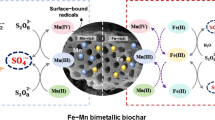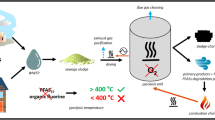Abstract
The effect of microbial sulfidogenesis on As transformation and mobilization in solid phase with low Fe/As ratio is still not well known. In this study, microbial transformation and mobilization of As in the As–Fe coprecipitate with different sulfate levels were investigated using chemical extraction and K-edge XANES of As and S. Results showed that approximately 2.7, 24.4, and 83.7 % of total As were released into the aqueous phase in the low-, mid-, and high-sulfate treatments, respectively, indicating that the presence of large amounts of sulfate could enhance microbial arsenic mobilization in the As–Fe coprecipitate. In the low-sulfate treatment, As mobilization was primarily attributed to the reductive dissolution of the Fe (oxy)hydroxides and the As reduction and desorption. In the mid- and high-sulfate treatments, the reduction of arsenate and ferric iron was significantly enhanced. Complete ferric iron reduction was observed in the solid phase, implying that Fe (oxy)hydroxide was transformed to secondary minerals and may be the one of the primary causes for the enhanced As mobilization. Thermodynamic calculations predicted the formation of thioarsenite species after 35 days of incubation based on the concentration of dissolved As(III) and S(−II). Since thioarsenic species is more mobile, its formation may be one of the most important factors enhancing the As release in the high-sulfate system. The result of this study is of significance to completely predict the environmental behavior of As associated with Fe (hydr)oxides in the presence of microbial sulfidogenesis under anoxic conditions.







Similar content being viewed by others
References
Beak DG, Wilkin RT, Ford RG, Kelly SD (2008) Examination of arsenic speciation in sulfidic solutions using X-ray absorption spectroscopy. Environ Sci Technol 42(5):1643–1650
Burton ED, Johnston SG, Bush RT (2011) Microbial sulfidogenesis in ferrihydrite-rich environments: effects on iron mineralogy and arsenic mobility. Geochim Cosmochim Acta 75(11):3072–3087
Burton ED, Johnston SG, Kraal P, Bush RT, Claff S (2013a) Sulfate availability drives divergent evolution of arsenic speciation during microbially mediated reductive transformation of schwertmannite. Environ Sci Technol 47(5):2221–2229
Burton ED, Johnston SG, Planer-Friedrich B (2013b) Coupling of arsenic mobility to sulfur transformations during microbial sulfate reduction in the presence and absence of humic acid. Chem Geol 343:12–24
Campbell KM, Malasarn D, Saltikov CW, Newman DK, Hering JG (2006) Simultaneous microbial reduction of iron(III) and arsenic(V) in suspensions of hydrous ferric oxide. Environ Sci Technol 40(19):5950–5955
Couture RM, Rose J, Kumar N, Mitchell K, Wallschlager D, Van Cappellen P (2013) Sorption of arsenite, arsenate, and thioarsenates to iron oxides and iron sulfides: a kinetic and spectroscopic investigation. Environ Sci Technol 47(11):5652–5659
Cutting RS, Coker VS, Telling ND, Kimber RL, Van Der Laan G, Pattrick RAD, Vaughan DJ, Arenholz E, Lloyd JR (2012) Microbial reduction of arsenic-doped schwertmannite by Geobacter sulfurreducens. Environ Sci Technol 46(22):12591–12599
Dixit S, Hering JG (2003) Comparison of arsenic(V) and arsenic(III) sorption onto iron oxide minerals: implications for arsenic mobility. Environ Sci Technol 37(18):4182–4189
Ekstrom EB, Learman DR, Madden AS, Hansel CM (2010) Contrasting effects of Al substitution on microbial reduction of Fe(III) (hydr)oxides. Geochim Cosmochim Acta 74(24):7086–7099
Farquhar ML, Charnock JM, Livens FR, Vaughan DJ (2002) Mechanisms of arsenic uptake from aqueous solution by interaction with goethite, lepidocrocite, mackinawite, and pyrite: an X-ray absorption spectroscopy study. Environ Sci Technol 36(8):1757–1762
Ford RG (2002) Rates of hydrous ferric oxide crystallization and the influence on coprecipitated arsenate. Environ Sci Technol 36(11):2459–2463
Harris B (2000) The removal and stabilization of As from aqueous process solutions: past, present, future. In: Young C et al (eds) Minor elements 2000, processing and environmental aspects of As, Sb, Se, Te, and Bi. SME, Littleton
Harris B (2003) The removal of arsenic from process solutions: theory and industrial practice. In: Ritchie IM, Young CAA, Anderson C, James A, Dreisinger D, Harris B (eds) Hydrometallurgy 2003—Proceedings of the International Symposium. TMS, Warrendale, pp 1889–1902
Hering JG, Chen PY, Wilkie JA, Elimelech M (1997) Arsenic removal from drinking water during coagulation. J Environ Eng ASCE 123(8):800–807
Huang JH, Elzinga EJ, Brechbuchl Y, Voegelin A, Kretzschmar R (2011a) Impacts of Shewanella putrefaciens strain CN-32 cells and extracellular polymeric substances on the sorption of As(V) and As(III) on Fe(III)-(hydr)oxides. Environ Sci Technol 45(7):2804–2810
Huang JH, Voegelin A, Pombo SA, Lazzaro A, Zeyer J, Kretzschmar R (2011b) Influence of arsenate adsorption to ferrihydrite, goethite, and boehmite on the kinetics of arsenate reduction by Shewanella putrefaciens strain CN-32. Environ Sci Technol 45(18):7701–7709
Islam FS, Gault AG, Boothman C, Polya DA, Charnock JM, Chatterjee D, Lloyd JR (2004) Role of metal-reducing bacteria in arsenic release from Bengal delta sediments. Nature 430(6995):68–71
Islam FS, Pederick RL, Gault AG, Adams LK, Polya DA, Charnock JM, Lloyd JR (2005) Interactions between the Fe(III)-reducing bacterium Geobacter sulfurreducens and arsenate, and capture of the metalloid by biogenic Fe(II). Appl Environ Microbiol 71(12):8642–8648
Jain A, Raven KP, Loeppert RH (1999) Arsenite and arsenate adsorption on ferrihydrite: surface charge reduction and net OH- release stoichiometry. Environ Sci Technol 33(8):1179–1184
Jia YF, Demopoulos GP (2008) Coprecipitation of arsenate with iron(III) in aqueous sulfate media: effect of time, lime as base and co-ions on arsenic retention. Water Res 42(3):661–668
Jonsson J, Sherman DM (2008) Sorption of As(III) and As(V) to siderite, green rust (fougerite) and magnetite: implications for arsenic release in anoxic groundwaters. Chem Geol 255(1–2):173–181
Kirk MF (2010) Experimental analysis of arsenic precipitation during microbial sulfate and iron reduction in model aquifer sediment reactors (vol 74, pg 2538, 2010). Geochim Cosmochim Acta 74(15):4603
Kirk MF, Roden EE, Crossey LJ, Brearley AJ, Spilde MN (2010) Experimental analysis of arsenic precipitation during microbial sulfate and iron reduction in model aquifer sediment reactors. Geochim Cosmochim Acta 74(9):2538–2555
Langner HW, Inskeep WP (2000) Microbial reduction of arsenate in the presence of ferrihydrite. Environ Sci Technol 34(15):3131–3136
Li YL, Vali H, Yang J, Phelps TJ, Zhang CL (2006) Reduction of iron oxides enhanced by a sulfate-reducing bacterium and biogenic H2S. Geomicrobiol J 23(2):103–117
Murphy R, Lammers K, Smirnov A, Schoonen MAA, Strongin DR (2010) Ferrihydrite phase transformation in the presence of aqueous sulfide and supercritical CO2. Chem Geol 271(1–2):26–30
Planer-Friedrich B, London J, McCleskey RB, Nordstrom DK, Wallschlager D (2007) Thioarsenates in geothermal waters of Yellowstone National Park: determination, preservation, and geochemical importance. Environ Sci Technol 41(15):5245–5251
Poulton SW (2003) Sulfide oxidation and iron dissolution kinetics during the reaction of dissolved sulfide with ferrihydrite. Chem Geol 202(1–2):79–94
Rhine ED, Garcia-Dominguez E, Phelps CD, Young LY (2005) Environmental microbes can speciate and cycle arsenic. Environ Sci Technol 39(24):9569–9573
Rochette EA, Bostick BC, Li GC, Fendorf S (2000) Kinetics of arsenate reduction by dissolved sulfide. Environ Sci Technol 34(22):4714–4720
Saalfield SL, Bostick BC (2009) Changes in iron, sulfur, and arsenic speciation associated with bacterial sulfate reduction in ferrihydrite-rich systems. Environ Sci Technol 43(23):8787–8793
Smedley PL, Kinniburgh DG (2002) A review of the source, behaviour and distribution of arsenic in natural waters. Appl Geochem 17(5):517–568
Stachowicz M, Hiemstra T, van Riemsdijk WH (2008) Multi-competitive interaction of As(III) and As(V) oxyanions with Ca2+, Mg2+, PO43-, and CO32- ions on goethite. J Colloid Interface Sci 320(2):400–414
Stauder S, Raue B, Sacher F (2005) Thioarsenates in sulfidic waters. Environ Sci Technol 39(16):5933–5939
Tadanier CJ, Schreiber ME, Roller JW (2005) Arsenic mobilization through microbially mediated deflocculation of ferrihydrite. Environ Sci Technol 39(9):3061–3068
Twidwell LG, Robins RG, Hohn JW (2005) The removal of arsenic from aqueous solution by coprecipitation with iron (III). In: Reddy RG, Ramachandran V (eds) Arsenic metallurgy. TMS, Warrendale, pp 3–24
Vignona LC (1985) Oxidation-reduction kinetics of goethite and dissolved sulfide; implications for trace metal desorption. Rice University
Weber FA, Hofacker AF, Voegelin A, Kretzschmar R (2010) Temperature dependence and coupling of iron and arsenic reduction and release during flooding of a contaminated soil. Environ Sci Technol 44(1):116–122
Wilkie JA, Hering JG (1996) Adsorption of arsenic onto hydrous ferric oxide: effects of adsorbate/adsorbent ratios and co-occurring solutes. Coll Surf A Physicochem Eng Asp 107:97–110
Xiao F, Wang S, Xu L, Wang Y, Yuan Z, Jia Y (2015) Adsorption of monothioarsenate on amorphous aluminum hydroxide under anaerobic conditions. Chem Geol 407–408:46–53
Xu L, Zhao Z, Wang S, Pan R, Jia Y (2011) Transformation of arsenic in offshore sediment under the impact of anaerobic microbial activities. Water Res 45(20):6781–6788
Zobrist J, Dowdle PR, Davis JA, Oremland RS (2000) Mobilization of arsenite by dissimilatory reduction of adsorbed arsenate. Environ Sci Technol 34(22):4747–4753
Acknowledgments
The S and As K-edge XANES spectra were measured on the mid-energy and XAFS beamlines at the Beijing Synchrotron Radiation Facility. The financial supports to this work by the Strategic Priority Research Program of the Chinese Academy of Sciences (No. XDB14020203) and the National Natural Science Foundation of China are gratefully acknowledged (Nos. 41530643, 41273133, 41303088, and 41473111).
Author information
Authors and Affiliations
Corresponding author
Additional information
Responsible editor: Robert Duran
Electronic supplementary material
Below is the link to the electronic supplementary material.
ESM 1
(DOCX 115 kb)
Rights and permissions
About this article
Cite this article
Wang, S., He, X.Y., Pan, R. et al. The effect of microbial sulfidogenesis on the stability of As–Fe coprecipitate with low Fe/As molar ratio under anaerobic conditions. Environ Sci Pollut Res 23, 7267–7277 (2016). https://doi.org/10.1007/s11356-015-5927-z
Received:
Accepted:
Published:
Issue Date:
DOI: https://doi.org/10.1007/s11356-015-5927-z




